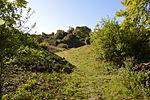Ashwell Springs
Ashwell, HertfordshireRiver CamSites of Special Scientific Interest in HertfordshireSites of Special Scientific Interest notified in 1986

Ashwell Springs is a 0.3-hectare (0.74-acre) biological Site of Special Scientific Interest in Ashwell in Hertfordshire, England. The local planning authority is North Hertfordshire District Council.The site consists of a series of freshwater springs, which form a source for the River Cam. Due to the low temperatures of the spring pools, they provide a habitat for cold water, invertebrate animals, some of which are rare. The site is particularly important for flatworms, including Crenobia alpina and the Polycelis felina. The pools are surrounded by grassland which provide shade for the water.There is access from the High Street and by a footpath from Hodwell.
Excerpt from the Wikipedia article Ashwell Springs (License: CC BY-SA 3.0, Authors, Images).Ashwell Springs
Springhead, North Hertfordshire
Geographical coordinates (GPS) Address External links Nearby Places Show on map
Geographical coordinates (GPS)
| Latitude | Longitude |
|---|---|
| N 52.04206 ° | E -0.1497 ° |
Address
Ashwell Springs
Springhead
SG7 5LL North Hertfordshire
England, United Kingdom
Open on Google Maps










